
This a book describing how ICT is continuing in Baa Atoll. It is a useful source for all the teachers.
- Subject:
- Career and Technical Education
- Material Type:
- Module
- Date Added:
- 02/02/2016

This a book describing how ICT is continuing in Baa Atoll. It is a useful source for all the teachers.
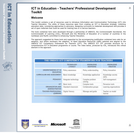
This toolkit contains a set of resources used to introduce Information and Communication Technology (ICT) into Teacher Education. The utility of these resources span from creating an ICT in Education strategy, collecting education data, considering approaches to advocacy, designing curriculum to materials development and provides a set of open materials that could be used for training new or in service teachers.

In this unit of study we will investigate what has emerged as global good practice in terms of ICT and education, as well as identify what your role as a teacher is in this regard. In this unit we will look specifically at ICT in Education Policy and the role of the teacher.
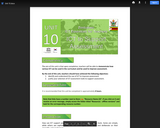
The aim of this unit is that upon completion, teachers will be able to demonstrate how various ICT can be used in the curriculum and be used to improve assessment.
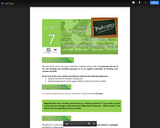
The aim of this unit is that upon completion, the teachers will be able to incorporate the use of ICT into learning and teaching processes so as to support acquisition of learning area content and skills.
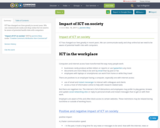
ICT has changed our lives greatly in recent years. We can communicate easily and shop online but we need to be aware of potential health risks with computers
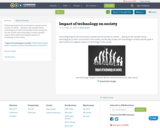
Technology impacts the environment, people and the society as a whole. ... Basing on the example above, technology by its self is not harmful to the society, but the way society uses technology to achieve specific goals is what results into negative impacts of technology on the society.
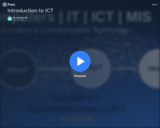
Brief presentation on introduction to ICT

Open Educational Resources (OER) are learning, teaching and research materials in any format and medium that reside in the public domain or are under copyright that have been released under an open license, that permit no-cost access, re-use, re-purpose, adaptation and redistribution by others.

This seminar is an introduction to the usage and impacts of information and communication technologies (ICTs) on urban planning, the urban environment and communities. Students will explore how social relationships, our sense of community, the urban infrastructure, and planning practice have been affected by technological change. Literature reviews, guest speakers, and web surfing will provide examples and issues that are debated in class and homework exercises. We will examine metropolitan information infrastructures, urban modeling and visualization, e-government, collaborative planning, and cyber communities.
Students will attend a regular Tuesday seminar and occasional seminars of invited speakers during lunchtime on Fridays or Mondays.
During the past two decades, ICTs have become so pervasive and disruptive that their impact on urban planning and social relationships has begun to reach far beyond their immediate use as efficient bookkeeping and automation tools. This seminar will examine ICT impacts on our sense of community, urban planning practice, the meaning of ‘place’, and the nature of metropolitan governance. In each of the four areas, we will utilize readings, class discussion, guest lectures, and homework exercises to identify and critique key trends, relevant theories, and promising directions for research and professional practice.

KICTCFT: The teacher can use authoring tools or environments to design online materials. Specific Objectives: On completion of this unit you should be able to, 1] Identify and discuss various authoring tools, 2] Select a suitable authoring tool, and 3] Design and develop online materials.

This instance of “Media, Education, and the Marketplace” focuses on the rise of information and communications technologies (ICTs) during the age of globalization, specifically examining its effect and potential in developing nations across the world. In particular, the class will focus on the following three components:
“Media” – ICTs, specifically the dramatic rise in use of the Internet over the past twenty years, have “globalized” the world and created opportunities where very few have been available in the past. We are entering a phase where an individual can significantly improve his or her own economical, political, and social circumstances with just a computer and Internet connection. This course investigate these profound developments through current research and case studies.
“Education” – With projects such as MIT’s OpenCourseWare, the major players in the world are beginning to understand the true power of ICTs in development. Throughout this class, we examine projects that harness the benefits of ICTs to create positive social change around the world.
“Marketplace” – The focus is on the developing regions of the world. Specifically, the term “digital divide” is tossed around in everyday language, but what does it really mean? Is there an international digital divide, a national digital divide, or both? Should we try to bridge this divide, and how have past attempts succeeded and (for the most part) failed? Why? These are all questions that are asked throughout this course.
This course has a very unique pedagogy, which is discussed in more detail in the syllabus section.

Media, Society, Culture, and You is an approachable introductory Mass Communication text that covers major mass communication terms and concepts including "digital culture." It discusses various media platforms and how they are evolving as Information and Communication Technologies change.
This book has been peer-reviewed by 6 subject experts and is now available for adoption or adaptation. If you plan to adopt or adapt this open textbook, please let us know by filling out our adoption form (https://docs.google.com/forms/d/e/1FAIpQLSdIj_Te3hiuJL7cKaofhhUHuDz3_hlVXg6Wg1IPcDZoH2pRrg/viewform?usp=sf_link).
You can view the book's Review Statement (https://press.rebus.community/mscy/back-matter/review-statement/) for more information about reviewers and the review process. An Accessibility Assessment (https://press.rebus.community/mscy/back-matter/accessibility-assessment/) for this is book has also been prepared to see how this book meets accessibility standards.

Can you make a cellphone change the world?
NextLab is a hands-on year-long design course in which students research, develop and deploy mobile technologies for the next billion mobile users in developing countries. Guided by real-world needs as observed by local partners, students work in multidisciplinary teams on term-long projects, closely collaborating with NGOs and communities at the local level, field practitioners, and experts in relevant fields.
Students are expected to leverage technical ingenuity in both mobile and internet technologies together with social insight in order to address social challenges in areas such as health, microfinance, entrepreneurship, education, and civic activism. Students with technically and socially viable prototypes may obtain funding for travel to their target communities, in order to obtain the first-hand feedback necessary to prepare their technologies for full fledged deployment into the real world (subject to guidelines and limitations).
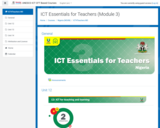
Module 3: Pedagogy
Unit 12: ICT for teaching and learning (traditional pedagogies)
Unit 13: ICT to support project-based learning
Unit 14: Strategies to support remote teaching
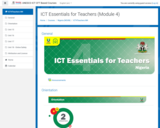
Module 4: Management and Administration
Unit 15: Organise ICT in the physical environment (labs, clusters, classrooms, virtual)
Unit 16: Use ICT for continued professional development
Unit 17: Responsible use of ICT in school and digital citizenship
Unit 18: Online safety
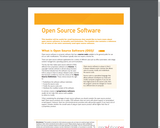
From last 2 decades the acceptance of ICT in every aspect of operations that facilitates the information organization and dissemination of information. Now a days the ICT tools like Open source Software very much popular in the data management and data organization, hence the Open source Software are the alternatives to most of the commercial software. All around the world due to The emergence of OSS no. of organization. offices and libraries etc. adopts OSS for their daily work. OSS has introduced a lot of new concept of managing the library and change the way in library daily operations. Open Source Software has become increasingly popular all around the world every year no. of software user migrate from proprietary software to open source software due to cost and functionality of the OSS.
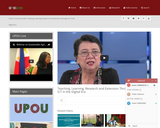
Grace Javier Alfonso, Ph.D, Professor Emeritus University of the Philippines Open University (UPOU) lectures on 'Teaching, Learning, Research and Extension Through ICT in the Digital Era'. She advocates Open, Distance e-Learning (ODeL), Learner-centered education, continuing professional development, lifelong learning and the sharing of open resources. Her lecture investigates OER and MOOCs and their significance for the Philippines.

Selecting appropriate Technologies
Short Description:
The use of open education is growing and has become a global movement. Across much of North America, most post-secondary institutions are in the process of integrating the use of open education resources into their teaching and learning activities. The number of OER repositories from which instructors can draw resources continues to grow each year. The number of resources continues to grow along with the number of different tools used to develop these resources. There are a number of commercial and open source digital technologies available for the creation of open resources. This resource is intended to provide the OER community with a summary of some currently available tools for creating open content. OER creators need to know the range of tools that can be used in the creation process. This guide is designed to provide a starting point for instructors and faculty at post-secondary institutions. Prospective creators of OER can use the guide to pick the most appropriate tool for their specific context and level of technical expertise.
Long Description:
The use of open education is growing and has become a global movement. Across much of North America, most post-secondary institutions are in the process of integrating the use of open education resources into teaching and learning activities. The following are the chapters covered in the guide: Chapter 1 starts with very basic information on the definition and description of what constitutes OER. Chapter 2 introduces the United Nations Sustainable Development Goals by providing a brief listing of each goal. Chapter 3 focuses on commercial word processing tool options. Chapter 4 describes a number of open-source word processing and additional tools. Chapter 5 introduces the basic open-source TeX-based systems that arose out of the open-source software movement. Chapter 6 delves further into TeX-based open-source tools by highlighting some packages useful for content creation. Chapter 7 describes other TeX-based tools helpful for creating open content. Chapter 8 introduces the emerging OER tools Pressbooks, EdTech Books and LibreTexts.
Word Count: 32461
(Note: This resource's metadata has been created automatically by reformatting and/or combining the information that the author initially provided as part of a bulk import process.)

Selecting appropriate Technologies
Short Description:
The use of open education is growing and has become a global movement. Across much of North America, most post-secondary institutions are in the process of integrating the use of open education resources into their teaching and learning activities. The number of OER repositories from which instructors can draw resources continues to grow each year. The number of resources continues to grow along with the number of different tools used to develop these resources. There are a number of commercial and open source digital technologies available for the creation of open resources. This resource is intended to provide the OER community with a summary of some currently available tools for creating open content. OER creators need to know the range of tools that can be used in the creation process. This guide is designed to provide a starting point for instructors and faculty at post-secondary institutions. Prospective creators of OER can use the guide to pick the most appropriate tool for their specific context and level of technical expertise.
Long Description:
The use of open education is growing and has become a global movement. Across much of North America, most post-secondary institutions are in the process of integrating the use of open education resources into teaching and learning activities. The following are the chapters covered in the guide: Chapter 1 starts with very basic information on the definition and description of what constitutes OER. Chapter 2 introduces the United Nations Sustainable Development Goals by providing a brief listing of each goal. Chapter 3 focuses on commercial word processing tool options. Chapter 4 describes a number of open-source word processing and additional tools. Chapter 5 introduces the basic open-source TeX-based systems that arose out of the open-source software movement. Chapter 6 delves further into TeX-based open-source tools by highlighting some packages useful for content creation. Chapter 7 describes other TeX-based tools helpful for creating open content. Chapter 8 introduces the emerging OER tools Pressbooks, EdTech Books and LibreTexts.
Word Count: 32474
ISBN: 978-0-7731-0777-9
(Note: This resource's metadata has been created automatically by reformatting and/or combining the information that the author initially provided as part of a bulk import process.)